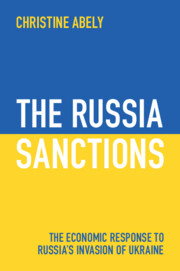Refine search
Actions for selected content:
15 results
12 - Money in the Global Power Game
-
- Book:
- Money In Crisis
- Published online:
- 15 July 2025
- Print publication:
- 12 June 2025, pp 304-334
-
- Chapter
- Export citation
Chapter 20 - Infrastructural Geoeconomics
- from Part III - Organizations and Actors of Contemporary Financial Infrastructures
-
-
- Book:
- The Cambridge Global Handbook of Financial Infrastructure
- Published online:
- 21 May 2025
- Print publication:
- 05 June 2025, pp 250-262
-
- Chapter
-
- You have access
- Open access
- HTML
- Export citation
Chapter 19 - SWIFT
- from Part III - Organizations and Actors of Contemporary Financial Infrastructures
-
-
- Book:
- The Cambridge Global Handbook of Financial Infrastructure
- Published online:
- 21 May 2025
- Print publication:
- 05 June 2025, pp 237-249
-
- Chapter
-
- You have access
- Open access
- HTML
- Export citation
Chapter 8 - Payments and Hegemony
- from Part I - Conceptual Approaches
-
-
- Book:
- The Cambridge Global Handbook of Financial Infrastructure
- Published online:
- 21 May 2025
- Print publication:
- 05 June 2025, pp 88-100
-
- Chapter
-
- You have access
- Open access
- HTML
- Export citation
Chapter 18 - Blame Game
- from Part III - Organizations and Actors of Contemporary Financial Infrastructures
-
-
- Book:
- The Cambridge Global Handbook of Financial Infrastructure
- Published online:
- 21 May 2025
- Print publication:
- 05 June 2025, pp 224-236
-
- Chapter
-
- You have access
- Open access
- HTML
- Export citation
5 - Digital Sovereignty and Payments
- from Part II - Techno-economic Structurings of Digital Sovereignty
-
-
- Book:
- Digital Sovereignty in the BRICS Countries
- Published online:
- 31 December 2024
- Print publication:
- 02 January 2025, pp 105-123
-
- Chapter
-
- You have access
- Open access
- HTML
- Export citation
Chapter 2 - Pythagoreans; or, Vegetarians before ‘Vegetarianism’
-
- Book:
- Vegetarianism and Veganism in Literature from the Ancients to the Twenty-First Century
- Published online:
- 30 May 2024
- Print publication:
- 06 June 2024, pp 20-63
-
- Chapter
- Export citation
3 - The Financial Sanctions and Impact on the Global Financial System
-
- Book:
- The Russia Sanctions
- Published online:
- 14 December 2023
- Print publication:
- 21 December 2023, pp 27-39
-
- Chapter
- Export citation

The Russia Sanctions
- The Economic Response to Russia's Invasion of Ukraine
-
- Published online:
- 14 December 2023
- Print publication:
- 21 December 2023
Chapter 1 - Johnson’s Compassion
- from Part I - Johnson’s Criticism and the Forms of Feeling
-
- Book:
- The Literary Criticism of Samuel Johnson
- Published online:
- 07 September 2023
- Print publication:
- 21 September 2023, pp 17-33
-
- Chapter
-
- You have access
- Open access
- HTML
- Export citation
5 - Around the Liberties
-
- Book:
- Dublin
- Published online:
- 16 February 2023
- Print publication:
- 09 March 2023, pp 96-119
-
- Chapter
- Export citation
7 - The Importance of the Offshore RMB Market
-
- Book:
- One Currency, Two Markets
- Published online:
- 17 June 2021
- Print publication:
- 08 July 2021, pp 194-240
-
- Chapter
- Export citation
Chapter 4 - Mental Illness
- from Part II - Psyche and Soma
-
-
- Book:
- Literature and Medicine
- Published online:
- 03 June 2021
- Print publication:
- 24 June 2021, pp 91-112
-
- Chapter
- Export citation
Chapter 2 - Economies of Scale from Aphra Behn to Sarah Scott
- from Part II - The Colonial Body: From Behn to Goethe
-
- Book:
- The Prosthetic Imagination
- Published online:
- 18 September 2020
- Print publication:
- 03 September 2020, pp 73-116
-
- Chapter
- Export citation
Chapter 1 - A Complete System of Atheism: Jonathan Swift
-
- Book:
- Godless Fictions in the Eighteenth Century
- Published online:
- 06 August 2020
- Print publication:
- 09 July 2020, pp 22-72
-
- Chapter
- Export citation
